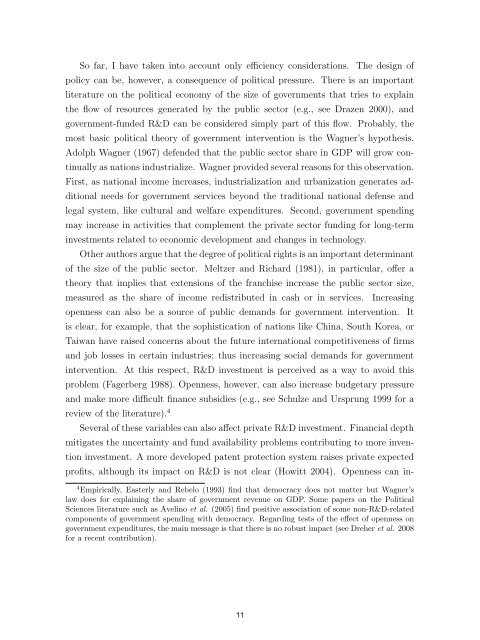Download - Ivie
You also want an ePaper? Increase the reach of your titles
YUMPU automatically turns print PDFs into web optimized ePapers that Google loves.
So far, I have taken into account only efficiency considerations. The design of<br />
policy can be, however, a consequence of political pressure. There is an important<br />
literature on the political economy of the size of governments that tries to explain<br />
the flow of resources generated by the public sector (e.g., see Drazen 2000), and<br />
government-funded R&D can be considered simply part of this flow. Probably, the<br />
most basic political theory of government intervention is the Wagner’s hypothesis.<br />
Adolph Wagner (1967) defended that the public sector share in GDP will grow continually<br />
as nations industrialize. Wagner provided several reasons for this observation.<br />
First, as national income increases, industrialization and urbanization generates additional<br />
needs for government services beyond the traditional national defense and<br />
legal system, like cultural and welfare expenditures. Second, government spending<br />
may increase in activities that complement the private sector funding for long-term<br />
investments related to economic development and changes in technology.<br />
Other authors argue that the degree of political rights is an important determinant<br />
of the size of the public sector. Meltzer and Richard (1981), in particular, offer a<br />
theory that implies that extensions of the franchise increase the public sector size,<br />
measured as the share of income redistributed in cash or in services.<br />
Increasing<br />
openness can also be a source of public demands for government intervention.<br />
is clear, for example, that the sophistication of nations like China, South Korea, or<br />
Taiwan have raised concerns about the future international competitiveness of firms<br />
and job losses in certain industries; thus increasing social demands for government<br />
intervention. At this respect, R&D investment is perceived as a way to avoid this<br />
problem (Fagerberg 1988). Openness, however, can also increase budgetary pressure<br />
and make more difficult finance subsidies (e.g., see Schulze and Ursprung 1999 for a<br />
review of the literature). 4<br />
Several of these variables can also affect private R&D investment. Financial depth<br />
mitigates the uncertainty and fund availability problems contributing to more invention<br />
investment. A more developed patent protection system raises private expected<br />
profits, although its impact on R&D is not clear (Howitt 2004). Openness can in-<br />
4 Empirically, Easterly and Rebelo (1993) find that democracy does not matter but Wagner’s<br />
law does for explaining the share of government revenue on GDP. Some papers on the Political<br />
Sciences literature such as Avelino et al. (2005) find positive association of some non-R&D-related<br />
components of government spending with democracy. Regarding tests of the effect of openness on<br />
government expenditures, the main message is that there is no robust impact (see Dreher et al. 2008<br />
for a recent contribution).<br />
It<br />
8<br />
11

















